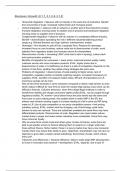Summary
Summary Theme 3 notes
- Course
- Institution
- Book
I have gone through each past paper question including the old spec, to see what type of answers are wanted according to the mark scheme. In this way I have formulated a doc, which includes everything that is necessary and relevant to include and know in your paper.
[Show more]




